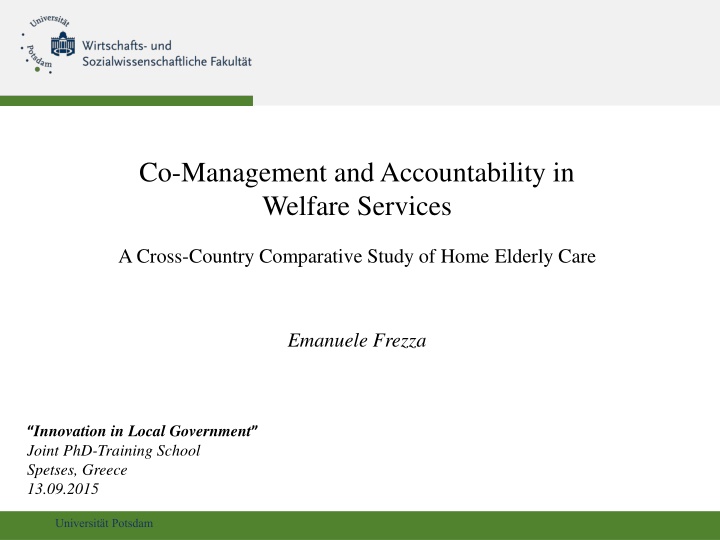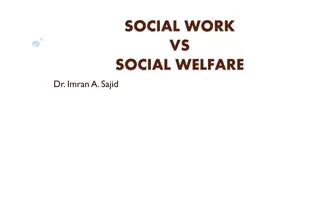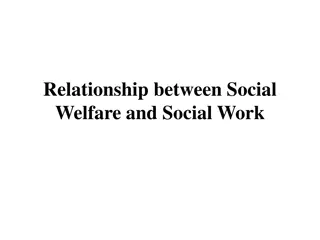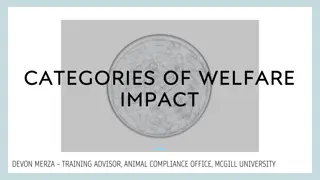
Co-Management and Accountability in Welfare Services
Cross-country comparison on co-management in welfare services for home elderly care, exploring public-third sector partnerships, accountability mechanisms, and factors influencing accountability types.
Download Presentation

Please find below an Image/Link to download the presentation.
The content on the website is provided AS IS for your information and personal use only. It may not be sold, licensed, or shared on other websites without obtaining consent from the author. If you encounter any issues during the download, it is possible that the publisher has removed the file from their server.
You are allowed to download the files provided on this website for personal or commercial use, subject to the condition that they are used lawfully. All files are the property of their respective owners.
The content on the website is provided AS IS for your information and personal use only. It may not be sold, licensed, or shared on other websites without obtaining consent from the author.
E N D
Presentation Transcript
Co-Management and Accountability in Welfare Services A Cross-Country Comparative Study of Home Elderly Care Emanuele Frezza Innovation in Local Government Joint PhD-Training School Spetses, Greece 13.09.2015 Universit t Potsdam
Co-management The term co-management refers to an arrangement in which the third sector produces public services in collaboration with the state (Pestoff and Brandsen, 2008). Co-managing public services with third sector organisations represents a relevant source of innovation in the on-going process of public administration reform. The simultaneous engagement of public and non-profit stakeholders for the delivery of a wide range of services occurs mostly at the local level and it has become increasingly common. Even though literature on the topic of joint collaborations between state and third sector actors is extensive, the notion of co-management is still observed by scholars without the support of a unique theoretical and analytical framework. Universit t Potsdam
Accountabilty in Public-Third Sector Partnerships: a contested issue In several Western European countries, the creation of public-third sector partnerships for the purpose of welfare services delivery represents an example of a diffused and expanding co-management practice However, within those partnerships, public administrations are faced with the need and pressure to hold third sector organisations accountable for quality of service provision and such task is becoming more complex and contested given that: Several types of public-third sector partnerships have been established and their change and reorganisation are constantly in motion. Different accountability mechanisms are progressively introduced into different partnerships, leading to the identification of specific accountability types. Distinct accountability types seem to have become predominant in countries characterized by distinct welfare and administrative systems. Universit t Potsdam
RQ: Under what conditions are third sector organisations held accountable to public administration when welfare services are co-managed through partnership agreements? RQ1: What types of public-third sector partnerships exist in Italy, Germany and the United Kingdom for the provision of welfare services? RQ2: What accountability mechanisms are introduced within them? RQ3: What factors influence the emergence of specific types of accountability? Universit t Potsdam
Public-Third Sector Partnership Types: a theoretical insight 1) Contracting: the state devolves social services delivery to third sector organisations, however remaining the sole responsible for service provision. 2) Third-party government: service delivery is still transferred to third sector actors, but additional tools can be used by the public authority to allow individuals to choose their own service provider. 3) Cooperation: a relation where there is free flow of information between the two sectors, non-profit organisations follow government rules and government s policy is neutral towards them. 4) Complementarity: a relationship where mutual benefit results from complementary advantages offered by the two sectors and it often entails long-term relations based on a mutual dependence that is both technical and financial in nature. 5) Collaboration: it implies higher formalization and the direct involvement of third sector organisations also in planning and policy making activities. Universit t Potsdam
Trends in motion The introduction of market mechanisms based on contracts and open competition has increased the number of private for-profit service providers (Chapman et al. 2010). Such process is challenging the role of non-profit providers, in particular of those who used to operate in close link with local administrations under almost uncompetitive condition. Existing public-third sector partnerships are evolving towards more socially embedded relationships (Bode and Brandsen, 2014; p. 1063), in which collaborative arrangements entail a more direct participation of social services users/receivers as co- producers together with the involvement of other significant civic stakeholders. Universit t Potsdam
ITALY GERMANY UK Administrative System Southern European Napoleonic Administrative System Continental European Napoleonic Administrative System Anglo-Saxon Administrative Tradition Rule-of-Law (Rechtsstaat) Legalism Clientelism Administrative Tradition Rule-of-Law (Rechtsstaat) Legalism Administrative Tradition Public Interest Culture Pragmatism Administrative Structure Centralized Weak local government Administrative Structure Decentralized Strong local government Administrative Structure Centralized Strong local government Recent Recentralization Administration-Citizens Relationship Formalized regulatory culture Administration-Citizens Relationship Formalized regulatory culture Administration-Citizens Relationship Flexible bargaining culture Welfare State Model Conservative Dual Welfare State Model Conservative Corporatist Welfare State Model Liberal Universit t Potsdam
Defining Accountability Accountability can be defined as the relationship between an actor and a forum, in which the actor has an obligation to explain and justify his or her conduct, the forum can pose questions and pass judgment, and the actor may face consequences (Bovens, 2007, p. 450) The complexity of public-third sector partnership arrangements to co-manage welfare services requires the establishment of a multi-dimensional accountability relation Universit t Potsdam
Emerging Accountability Types 1) Managerial accountability: it focuses on assessing how efficiently resources are used by third sector organisations to deliver social services; attention is especially devoted to the monitoring of inputs and outputs, or outcomes, rather than to the observation of the processes through which inputs are transformed. 2) Legal (or operational) accountability: it involves the external monitoring of third sector organisations activities in order to assess their compliance with established standards and rules; main focus is on the formal oversight and legal scrutiny of processes and procedures. 3) Professional accountability: it reflects collaborative arrangements that afford high autonomy to third sector organisations for the provision of services, in virtue of their working expertise; monitoring and control focus on the evaluation of outcomes and they usually involve processes of on-going consultation. Universit t Potsdam
Research Design: The Policy Field of Home Elderly Care Projected old-age dependency ratio 60 50 40 Germany 30 Italy UK 20 10 0 2013 2020 2030 2040 2050 Source: Eurostat Population Projections 2010-based Universit t Potsdam
Research Design: The Policy Field of Home Elderly Care Demographic factor: an increase of the incidence of older population on younger active population translates into an increased demand for social assistance. Resource availability factor: limited amount of public resources is challenging local governments in the provision of elderly support through hospitalization or other forms of institutionalized care. Establishment of partnerships with third sector organizations to facilitate alternative care solutions as a viable and necessary choice. Provision of home-based assistance through the joint effort of public and third sector actors as one of the latest developments of social elderly care in Europe. Home elderly care as an expanding domain especially in Western European countries, where the share of elderly frail people is recording the highest increase (Bode, 2006). Universit t Potsdam
Methodology STEP 1: Case studies with semi-structured interviews (RQ 1 & RQ 2) Map and selection of partnership experiences (i.e. cases) where all three main types of accountability have emerged. Idea is to select a medium-N sample of cases in order to cover a broad range of possible partnerships (10 cases per country, for a total of 30 cases). Identification of partnership types according to specific contractual features: 1) Duration of the partnership agreement - short term - long term 2) Type of care and assistance provided - socio-related aspects - health-relatedaspects 3) Intensity of care provided - actual number of days of care - technical requirements for care delivery 4) Type of human resources involved - professional carers - voluntarycarers 5) Form of funding third sector care providers - direct financial support - indirect financial support Identification of the mechanisms and practices introduced by local governments to hold third sector organisations accountable when co-managing home elderly care. Universit t Potsdam
Methodology STEP 2: Fuzzy-set Qualitative Comparative Analysis (RQ 3) Investigation of causal conditions or combinations of causal conditions for the emergence of a specific dominant accountability type. Independent Variables Dependent Variable 1) Partnerships contractual features Dominant accountability type: (managerial, legal, professional) 2) Socio-administrative contextual features Assumption: Contractual features according to which partnership types have been clustered as well as country- specific socio-administrative features might represent causal explanations for the emergence of a dominant accountability type. Such endogenous (contractual) and exogenous (contextual) features can be seen as factors whose causal effect on the emergence of each accountability type should be tested. Universit t Potsdam
Selected References Bernstein, S. (1991). Managing Contracted Services in the Nonprofit Agency. Philadelphia: Temple University Press. Bode, I. (2006). Co-Governance within Networks and the Nonprofit-Forprofit Divide. A Cross-Cultural Perspective on the Evolution of Domiciliary Elderly Care. Public Management Review, 8 (4): 551 566. Bode, I. and Brandsen, T. (2014). State-third Sector Partnerships: A short overview of key issues in the debate. Public Management Review, 16 (8): 1055-1066. Bovens, M. (2007). Analysing and assessing accountability: A conceptual framework. European Law Journal, 13: 447 468. Brandsen, T., Oude Vrielink, M., Schillemans T. and van Hout, E. (2011). Non-Profit Organisations, Democratisation, and New Forms of Accountability . In Ball, A. and Osborne, S.P. (eds). Social Accounting and Public Management, pp. 90-102. New York: Routledge Taylor and Francis Group. Brandsen, T. and van Hout, E. (2006). Co-management in public service networks. Public Management Review, 8 (4): 537-549. Chapman, T., Brown, J., Ford, C. and Baxter, B. (2010). Trouble with Champions: Local Public Sector-Third Sector Partnerships and the Future Prospects for Collaborative Governance in the UK. Policy Studies, 31 (6): 613 630. DeHoog, R. H. (1990). Competition, Negotiating or Cooperation: Three Models for Service Contracting. Administration and Society. 22 (3): 317-340. DiMaggio, P. J. and Powell, W. W. (1983). The iron cage revisited: institutional isomorphism and collective rationality in organizational fields. American Sociological Review, 48 (1): 147-160. Dubnick, M. J. and Frederickson, H. G. (2010). Accountable agents: Federal performance measurement and third-party government. Journal of Public Administration Research and Theory, 20: 143-159. Eurostat Demoghraphic data: Population projections 2010-based. Evers, A. (2005). Mixed Welfare Systems and Hybrid Organizations: Changes in the Governance and Provision of Social Services. International Journal of Public Administration, 28 (9 10): 737 748. Evers, A and Laville, J. L. eds. (2004). The Third Sector in Europe. Cheltenham: Edward Elgar. Ferris, J. M. (1993). The Double-Edged Sword of Social Service Contracting: Public Accountability Versus Nonprofit Autonomy. Nonprofit Management and Leadership, 3 (4): 363-376. Universit t Potsdam
Frumkin, P. (2005). On being Nonprofit. Harvard University Press: Cambridge, Massachusetts. Genet, N. et al. (2011). Home Care in Europe: a systematic literature review. BMC Health Services Research, 11:207. Hall, P. (2003). Aligning Ontology and Methodology in Comparative Research . In: Mahoney, J. and Rueschmeyer, D. (eds). Comparative Historical Analysis in the Social Science, pp. 373-404. Cambridge University Press, Cambridge. Kramer, R. (1981). Voluntary Agencies in the Welfare State. Berkeley: University of California Press, 1981. Pavolini, E. and Ranci, C. (2008). Restructuring the welfare state: reforms in long-term care in Western European countries. Journal of European Social Policy, 18 (3): 246-259. Pesaresi, F. and Gori, C. (2003). Servizi domiciliari e residenziali per gli anziani non autosufficienti in Europa. Tendenze Nuove, 4-5, pp. 433-0, doi: 10.1450/9538. Pestoff, V. and Brandsen, T. (2008). Co-Production: The Third Sector and the Delivery of Public Services. London: Routledge Taylor and Francis Group. Ragin, C. (2000). Fuzzy-Set Social Science. University of Chicago Press, Chicago. Rihoux, B (2006). Qualitative Comparative Analysis (QCA) and Related Systematic Comparative Methods. Recent Advances and Remaining Challenges for Social Science Research. International Sociology, 21, pp. 679 706. Salamon, L. M. (1995). Partners in Public Service: Government-Nonprofit Relations in the Modern Welfare State. Baltimore, Md: Johns Hopkins University Press. Schillemans, T. and Busuioc, M. (2014). Predicting Public Sector Accountability: From Agency Drift to Forum Drift. Journal of Public Administration Research and Theory, 25 (1): 191-215. Scott, W. R. and Meyer, J. W. (1991). The organization of societal sectors . In Powell, W. W. and DiMaggio, P. J. (eds.). The new institutionalism in organizational analysis, pp. 108-140. Chicago: University of Chicago Press. Suchman, M. C. (1995). Managing Legitimacy: Strategic and Institutional Approaches. The Academy of Management Review, 20 (3): 571- 610. Tarricone, R. and Tsouros, A. eds. (2008). Home Care in Europe: the solid facts. Copenhagen, WHO Regional Office for Europe. Universit t Potsdam
Thank you for your attention Universit t Potsdam






















